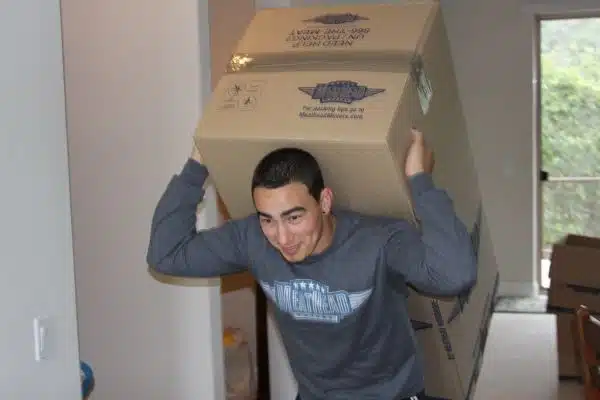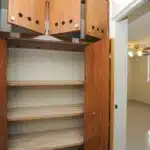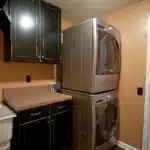As a professional moving and packing consultant, I understand the stress and anxiety that comes with packing up your entire household for a move. Packing can be overwhelming, time-consuming, and daunting, especially if you don’t know where to start. However, with a little bit of planning and organization, packing can be made much easier.
In this article, I will provide you with a room-by-room guide to help you pack your house efficiently and effectively. Whether you are moving across town or across the country, this guide will help you navigate through the packing process and ensure that everything is packed properly and ready for transport. From the kitchen to the bedroom to the garage, we will cover it all so that you can focus on settling into your new home with ease. So let’s get started!
The Kitchen: Packing Dishes, Appliances, And Food
The kitchen is often considered the heart of the home, a space where meals are prepared and families gather to share stories and laughter. As you prepare for your move, it’s important to handle this space with care to ensure that your dishes, appliances, and perishables arrive safely at your new home.
When packing dishes, start by wrapping each piece in bubble wrap or newspaper before placing them in a box. Be sure to fill any empty spaces with packing peanuts or crumpled paper to prevent shifting during transportation. For glasses and stemware, use dividers or cell boxes to keep them in place.
Organizing your kitchen appliances can be a daunting task. Start by removing any loose parts and wrapping them separately. Use foam padding or moving blankets to protect delicate surfaces. For larger appliances such as blenders and mixers, consider using their original packaging if available.
Packing perishables can be challenging but there are several options available. Consider donating unopened non-perishable items to a local food bank or giving away open items to friends or family. For perishable items such as frozen meats and vegetables, use an insulated cooler with ice packs during transport. With these tips in mind, you’ll be well on your way to organizing your kitchen for a successful move.
Next up is the living room: packing furniture and electronics.
The Living Room: Packing Furniture And Electronics
When it comes to packing your living room, furniture and electronics are the biggest items that need special attention. To protect your furniture during the move, it is important to disassemble any large pieces, such as sofas or bookshelves, and wrap them with furniture pads or blankets. This will help prevent scratches and dents during transportation. For smaller items like coffee tables or side tables, remove any legs or detachable parts and pack them separately.
Properly packing and labeling electronics is also crucial in ensuring they arrive safely at your new home. Start by taking photos of the wiring setup before disconnecting anything. Use color-coded tape or labels to mark which cords go with each device for easier reassembly later on. For fragile items like televisions or computer monitors, use a protective cover or box specifically designed for electronics.
By following these tips for protecting furniture during the move and properly packing and labeling electronics, you’ll have peace of mind knowing that your belongings are in good hands. In the next section, we’ll discuss how to pack delicate china, glassware, and serving pieces in the dining room.
The Dining Room: Packing China, Glassware, And Serving Pieces
The dining room can be one of the most challenging rooms to pack due to the fragility of its contents. When packing china, glassware, and serving pieces, it’s important to take extra care to ensure that no items are damaged during transit. Begin by wrapping each item in newspaper or bubble wrap and placing them in sturdy boxes. Use plenty of packing materials such as crumpled paper or foam peanuts to fill any empty spaces and prevent items from shifting around.
When organizing boxes efficiently, it’s best to pack similar items together. For example, place all plates in one box and all glasses in another. This not only makes unpacking easier but also helps prevent damage during transport. Label each box clearly with its contents and indicate which side is up to ensure proper handling.
Packing fragile items can be a time-consuming process, but the extra effort is worth it when you arrive at your new home with everything intact. Remember to handle each item with care and use plenty of padding materials when packing. By following these tips, you can successfully pack your dining room with ease and peace of mind knowing that your items will arrive safely at their destination. Next up, we’ll cover the bedroom and how to pack clothes, bedding, and personal items for your move.
The Bedroom: Packing Clothes, Bedding, And Personal Items
Imagery: Imagine walking into your bedroom and seeing clothes everywhere – on the bed, in the closet, and on the floor. It can be overwhelming to think about packing up all of these items for a move. However, with some minimalist packing techniques and organization, this process can be simplified.
Firstly, start by decluttering your wardrobe. Donate or sell any items that you no longer wear or need. This will not only reduce the amount of clothing you have to pack but also make it easier to organize your remaining items. Use vacuum-sealed bags or packing cubes to group similar clothing together and save space in boxes.
Next, when packing bedding, consider using it as padding for fragile items such as mirrors or picture frames. This will not only protect these items during transport but also save on packing materials. Finally, when it comes to personal items such as jewelry or sentimental objects, use small boxes or containers to keep them organized and easily accessible.
Minimalist Packing:
- Declutter your wardrobe before packing
- Use vacuum-sealed bags or packing cubes
- Consider using bedding as padding for fragile items
- Use small boxes or containers for personal items
Organizing Personal Items:
- Group similar clothing together
- Pack personal items in small boxes or containers
- Label each box with its contents for easy identification during unpacking
In summary, organizing your bedroom for a move can be simplified through minimalist packing techniques and organization strategies. By decluttering your wardrobe and using space-saving methods such as vacuum-sealed bags and packing cubes, you can pack efficiently while maximizing space in moving boxes. Remember to also use bedding as padding for fragile items and keep personal belongings organized in labeled containers.
The Bathroom: Packing Toiletries, Linens, And Medications
When it comes to packing your bathroom for a move, it’s important to start with organizing toiletries. Begin by gathering all of your toiletries together and sorting them into categories. This can include items like shampoo, conditioner, body wash, toothpaste, and other personal hygiene products. Once you have all of your items sorted, consider purchasing small storage containers or bags to keep them organized during the move.
Another important aspect of packing your bathroom is discarding expired medications. Go through your medicine cabinet and look for any medications that have expired or are no longer needed. It’s important to dispose of these properly in order to keep them out of the wrong hands. Check with your local pharmacy or healthcare provider for proper disposal methods.
When packing linens in your bathroom, be sure to use sturdy boxes or containers that will keep them clean and protected during transport. Roll towels and washcloths tightly and place them in the bottom of the box. Next, layer in hand towels and bath mats followed by shower curtains and liners. Finally, add any extra linens such as blankets or throws on top before sealing the box.
As we move on to the next section about packing up the home office, it’s important to remember that computers, printers, and important documents require special attention during a move. By following some simple tips and being diligent with organization, you can ensure that everything arrives at your new home safely and ready for use.
The Home Office: Packing Computers, Printers, And Important Documents
Just as protecting your toiletries, linens, and medications is crucial during a move, so too is safeguarding your electronic devices. Computers and printers are not only expensive but also hold important data that you don’t want to lose. To ensure their safety, start by backing up all of your files on an external hard drive or cloud storage before packing them away. Use bubble wrap or foam sheets to cushion the devices and boxes that fit them snugly to prevent any movement.
Organizing important documents is another crucial task when moving out of a home office. Start by going through all of the paperwork and sorting them into categories such as financial records, legal documents, and personal files. Make sure to label each folder clearly for easy identification later on. When it comes time to pack them away, use sturdy boxes and keep them separate from any other items that could cause damage.
Moving can be stressful for anyone but having children can make it even more challenging. The kids’ room often has a variety of items such as toys, books, clothing, and sentimental items that need special care when packing. Take the time to sort through everything with your child present so they feel involved in the process. Then label boxes for easy unpacking later on and consider donating any unwanted items to charity organizations in need.
The Kids’ Room: Packing Toys, Books, And Clothing
When it comes to packing the kids’ room, there are three main categories of items that need to be addressed: toys, books, and clothing. It’s important to approach each category with care, as they often contain sentimental items that can be difficult to part with.
Firstly, when it comes to packing toys, it’s a good idea to involve your children in the process. Encourage them to choose a select few favorite toys that will travel with them in their personal luggage or backpacks. For the rest of the toys, consider donating any unwanted items to a local charity or thrift store. This not only reduces the amount of clutter you have to pack but also helps those in need.
Next up are books. These can be particularly tricky if your child has an extensive collection. Start by sorting through all the books and deciding which ones your child wants to keep and which ones they can let go of. Once again, donating unwanted books is a great option here. If there are any particularly sentimental items that your child wants to hold on to but may not necessarily read anymore, consider packing them separately and labeling them clearly so that they don’t get lost during the move.
Finally, when it comes to clothing, start by decluttering and getting rid of any clothes that no longer fit or are out of season. From there, sort through remaining clothes and decide which ones are worth keeping for future use and which ones can be donated. Remember: less is more when it comes to moving house!
Moving on from packing up the kids’ room, let’s now take a look at how best to pack bedding and personal items from the guest room.
The Guest Room: Packing Bedding And Personal Items
As we move on to the guest room, it’s important to be mindful of the personal items and bedding that need to be packed. The guest room is often a place where we store extra linens, towels, and other necessities for our guests. When packing these items, consider using creative storage solutions to maximize space in your moving boxes. For example, fold linens and towels neatly and pack them inside vacuum-sealed bags to reduce their size.
Another important aspect to consider when packing the guest room is any personal items that may belong to your guests. Be sure to ask if they want any particular belongings packed or if they plan on taking them with them. If they do not want these items, consider donating unwanted items instead of packing them up and moving them with you. This not only reduces the amount of clutter you have but also helps those in need.
In summary, packing the guest room can be a simple process if you take into account some basic guidelines and tips. Consider creative storage solutions like vacuum-sealed bags for linens and towels. Also, don’t forget about personal belongings that may belong to your guests as these should be properly addressed before packing up the room. Lastly, donate unwanted items instead of taking them with you as this will help declutter your home while also assisting those in need. Moving on, let’s discuss how best to pack tools, outdoor equipment, and sports gear in the garage.
The Garage: Packing Tools, Outdoor Equipment, And Sports Gear
Garage Organization is a crucial aspect of preparing for a move. It is important to begin by sorting through all the tools, outdoor equipment, and sports gear that you have accumulated over time. This will help identify what needs to be packed and what can be left behind or donated. Once you have sorted everything, it is essential to properly store them to prevent any damage during transit.
Packing Tools can be a daunting task, but with proper organization, it can be made easier. Start by grouping similar tools together and then wrapping each tool in bubble wrap or packing paper before placing them in a sturdy box. Label each box with its contents for easy identification when unpacking at your new home. Outdoor Equipment such as lawn mowers, bicycles, and garden tools should also be carefully packed and secured in appropriate boxes or containers.
Storing Sports Equipment can also present a challenge when packing for a move. Begin by cleaning each item thoroughly to prevent any damage during storage or transit. Use appropriate boxes or containers designed to store specific sports equipment such as golf bags, hockey sticks, and tennis rackets. Label each container with its contents to make it easier to locate specific items when unpacking at your new home. Proper garage organization and storage of sports equipment will ensure that they are well-maintained during the move and ready for use once you arrive at your new home.
As we continue our room-by-room guide on packing your house for moving, the next section will cover ‘the attic: packing seasonal items and memorabilia.’
The Attic: Packing Seasonal Items And Memorabilia
Ironically, the attic is often treated as a dumping ground for items that we rarely use but cannot bear to throw away. However, when the time comes to move, it can be a daunting task to sort through all of the seasonal items and old memorabilia stored up there.
Attic organization is key when packing for a move. Begin by removing everything from the space and sorting it into piles of keep, donate, and toss. Seasonal items such as holiday decorations should be packed in sturdy boxes with labels indicating their contents. Old memorabilia should also be carefully packed using acid-free paper or plastic sleeves to preserve them during transport.
When packing sentimental items such as family heirlooms or childhood treasures, it’s important to take extra care. Wrap fragile items in bubble wrap and label them as fragile. For extra protection, consider placing these items in a climate-controlled storage unit until you are settled into your new home. With proper attic organization and preservation techniques, your cherished memories will arrive at your new home safely and intact.
As we move on to the next section of packing your house for moving, let’s turn our attention to the basement: packing storage items and home maintenance supplies.
The Basement: Packing Storage Items And Home Maintenance Supplies
The basement is commonly used for storing items that are not frequently used or simply don’t have a place in the rest of the house. To begin packing, take a thorough inventory of everything in the basement. Organizing your clutter into categories can help you determine what you need to keep and what can be donated or thrown away. This will also save time and energy when it comes to unpacking at your new home.
When packing storage items, use sturdy boxes and label them clearly with their contents. Be sure to pack fragile items with cushioning materials, such as bubble wrap or newspaper, to prevent damage during transit. It’s important to remember that many moving companies won’t transport hazardous materials such as gasoline or paint thinner, so it’s best to dispose of these types of items properly before moving day.
Lastly, don’t forget about home maintenance supplies. Gather all cleaning products, tools, and equipment in one designated area for easy access during move-out cleaning and move-in preparations. These items should be packed together in a separate box from other basement items, labeled accordingly, and kept within reach until they are needed at your new home.
Donating unwanted items is a great way to reduce clutter and start fresh in a new space. Consider giving away gently used clothing or household items to local charities or organizations in need. By doing so, you’ll not only declutter your home but also make a positive impact on your community. In the next section on packing the laundry room essentials, we’ll cover how to safely pack cleaning supplies and laundry necessities for an efficient move.
The Laundry Room: Packing Cleaning Supplies And Laundry Essentials
After carefully packing and organizing your storage items and home maintenance supplies in the basement, it’s time to move on to the laundry room. This space is often filled with various cleaning supplies and laundry essentials that need to be sorted through before packing.
Begin by gathering all of your cleaning supplies and separating them into categories such as bathroom cleaners, kitchen cleaners, and floor cleaners. Once you have them separated, decide which ones you will need for cleaning your current home before moving day. The rest can be packed away.
Next, turn your attention to the laundry essentials such as detergents, fabric softeners, and stain removers. Pack these items together in a box or container labeled “laundry room” for easy unpacking in your new home. If you have any unused or partially used items, consider donating them to a local shelter or charity.
Organizing supplies:
- Categorize cleaning supplies
- Bathroom cleaners
- Kitchen cleaners
- Floor cleaners
- Pack unused cleaning supplies
Donating unused items:
- Consider donating unused or partially used items
- Find a local shelter or charity
The Patio: Packing Outdoor Furniture And Grill
When packing outdoor furniture, it’s important to clean each item before packing it away. Use a mild soap and water solution to wipe down chairs, tables, and cushions. This will help prevent dirt and debris from transferring onto other items during the move. Once everything is clean and dry, consider wrapping each piece in a protective covering such as moving blankets or plastic wrap.
When it comes to protecting your grill during a move, there are a few things to keep in mind. Start by removing the propane tank if you have one. This should be transported separately from the grill itself. Next, disconnect any removable parts such as grates or burners and pack them securely in boxes with plenty of padding. Finally, wrap the entire grill in a tarp or moving blanket to protect it from scratches and dings.
Overall, taking the time to properly clean and protect your outdoor furniture and grill can save you headaches later on. By following these steps, you can rest easy knowing that your patio items will arrive at your new home in great condition. Now let’s move on to packing up the entryway!
The Entryway: Packing Shoes, Coats, And Umbrellas
The entryway is one of the most frequently used areas in any house, making it a priority when packing for a move. It’s important to start by sorting through shoes, coats, and umbrellas and deciding which items are worth taking with you to your new home. Consider using creative storage solutions such as over-the-door shoe racks or hanging coat organizers to maximize space and prevent clutter.
When it comes to packing shoes, consider using shoe boxes or plastic bags to protect them from dust and damage during transit. Be sure to label each box with the type of shoe inside for easy unpacking later on. For coats, use garment bags or large plastic bags to keep them clean and protected during the move. Keep umbrellas together in a designated box or container labeled “umbrellas” for easy access on a rainy day.
Minimizing clutter is key when packing your entryway. Donate any old coats or shoes that are no longer needed, and toss out any broken umbrellas. By doing so, you’ll not only save space but also make it easier to unpack once you’ve arrived at your new home. Remember, an organized entryway sets the tone for the rest of your move-in process.
In order to stay organized throughout the packing process, it’s important to label all boxes clearly with their contents and designated room in your new home. Additionally, if you find yourself struggling with packing or time management, consider hiring professional packers who can assist you with the entire process or just certain areas that may be more difficult for you. Finally, don’t forget that staying organized is key when moving; create checklists and timelines so that nothing falls through the cracks during this busy time.
Final Tips: Labeling Boxes, Hiring Professional Packers, And Staying Organized
As you near the end of your packing journey, there are a few final tips to keep in mind to ensure a smooth and organized move. One of the most important aspects is efficient labeling of your boxes. Take the time to label each box with its contents and which room it belongs in. This will make unpacking much easier and less stressful, as you’ll know exactly where everything goes.
Another option to consider is hiring professional packers. While it may seem like an additional expense, professional packers can save you time and energy by efficiently packing your belongings while also ensuring they are properly protected during transport. Additionally, hiring professionals can give you peace of mind knowing that your items are in good hands.
Throughout the moving process, staying organized is key. Keep track of important documents such as contracts and receipts, and create a checklist to ensure nothing is forgotten or left behind. Also, don’t hesitate to ask for help from friends or family members if needed. Remember that moving can be stressful, but with proper planning and organization, it can also be a positive experience full of new opportunities.
Overall, remember to take things one step at a time and stay focused on the end goal – settling into your new home. By following these final tips for labeling boxes efficiently, considering professional packers, and staying organized throughout the process, you’ll be well on your way to a successful move.
Conclusion
When it comes to packing up your entire house for a move, the thought of where to start can be daunting. But fear not, as a professional moving and packing consultant, I am here to guide you through the process room-by-room.
In the kitchen, carefully wrap and pack dishes and appliances in sturdy boxes. Don’t forget to use up or donate any perishable food items before moving day. In the living room, disassemble furniture and wrap electronics with protective materials. The dining room requires extra care when packing fragile china and glassware. In the bedroom, pack clothes and bedding in vacuum-sealed bags and label boxes clearly. The bathroom calls for careful packing of toiletries, linens, and medications. The laundry room needs attention when it comes to packing cleaning supplies and laundry essentials.
When it comes to outdoor items like patio furniture and grills, make sure they are clean and dry before packing them away. And don’t forget about your entryway – pack shoes, coats, and umbrellas in designated boxes.
To make things easier on yourself, label each box clearly with its contents and which room it belongs in. Consider hiring professional packers if you are short on time or overwhelmed with the task at hand.
By following this room-by-room guide to packing your house for moving day, you can ensure that your belongings arrive safely at your new home without any damage or stress along the way.
Image Credits
- “I got it! Moving box on back.” by Meathead Movers (featured)





























